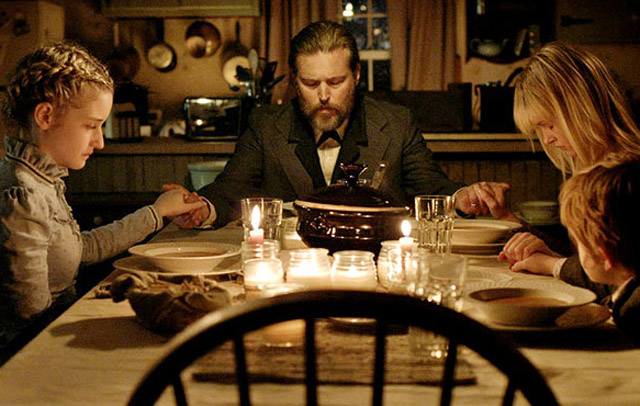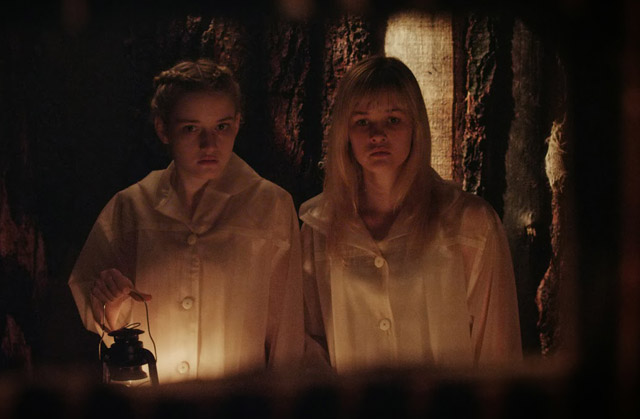CHICAGO – In anticipation of the scariest week of the year, HollywoodChicago.com launches its 2024 Movie Gifts series, which will suggest DVDs and collections for holiday giving.
Gothic Originality in ‘We Are What We Are’
 Rating: 3.5/5.0 |
CHICAGO – Finding something truly original in the horror genre is rare. The most effective scare tactics are ones that touch the heart of our familiarity and psychosis. Re-imagining a Mexican film from 2010, director Jim Mickle gets right to the gothic heart of it all in “We Are What We Are.”
Basing the main chilling ritual within an extreme religious sect is the main strength of the film, enough to overcome some serious story holes and turn-the-head-away representations of the ritual. We live in a world in which extreme religiosity causes war, buildings to explode and authoritarian thinking. Taking this to the nth degree in a horror film goes beyond the usual path of mixing religion and the genre, that of exorcism. Instead of just the “devil” being evil, “We Are What We Are” involves extreme interpretation of so-called righteousness, that the ends of faith and religion justify the means of perpetuating a force upon others outside the religion. It’s a rabbit hole harboring myth-as-truth and grand delusions, so grand that it destroys lives.
There is a flood coming, from days of endless rain. A woman is nervously shown purchasing the minimal items of survival. She is obviously physical ill, and falls dead before she can reach her truck. It turns out she is the mother of three children, in a home where an extreme reading of a Christian religious sect by the father (Bill Sage) has virtually imprisoned everyone inside the family.
 Photo credit: Entertainment One |
With the mother gone, the two teenage girls Iris (Ambyr Childers) and Rose (Julia Garner) are put in charge of her duties. A breakdown has occurred with their father because of the loss, and the exposure of the family has a Sheriff’s deputy (Wyatt Russell), the town doctor (Michael Parks) and a virtuous neighbor (Kelly McGillis) infiltrating their secrets. There is one particular ritual that becomes the fatal flaw in the intersection of religion and their lives.
Using the biblical element of it takes-a-disaster-to-expose-sins, the use of a flood is very powerful to start the breakdown of the father. It is the flood that causes the mother to act, it is the floodwaters that purifies her death and it is the aftermath that exposes clues to the family’s influence on the town. This force of true elements of nature interacting with the religious mythology is just part of how the truth is uncovered.
The casting in the film is appropriate to small town archetypes and the hero or villain within them. Bill Sage as the father and religious zealot never breaks from his point of view, even as his evaluations start to break him mentally. He is a monster that is difficult to stop, because he knows no other life. Michael Parks – the veteran 1960s TV actor – is nearly perfect as the town doctor, counterbalancing the possessive religious force with a Sherlock Holmes-like precision in breaking down the walls of the intolerant.
The actors playing the two teenage daughters – Ambyr Childers and Julia Garner – are almost Lolita-like, a temptation beyond their home life and roots. This also calls out the power of nature over man-made religious temperance, and it is the girls that eventually lead the way to resolution. Kelly McGillis as kindly neighbor Marge is also notable, especially considering she has had two lives as a movie star – the former sexpot and now a go-to character actor. She has had a unique and remarkable career.
 Photo credit: Entertainment One |
The film has holes in logic – the necessity of the ritual causes a suspicious amount of disappearances, for example – but none that trip up the overall mystery. There is a noteworthy amount of C.S.I.-style gore, but it is revealed as part of the ritual, which emphasizes the extreme terror of taking an interpretation to action, and the consequences of that action.
“We Are What We Are” is gothic, mysterious and explained through the current extremities of attitude that has plagued reasonable compromise. How does a ritual develop unless somebody can convince somebody else that it exists, which causes the stormfront of religion, politics and anything that is holier-than-thou.
 | By PATRICK McDONALD |


